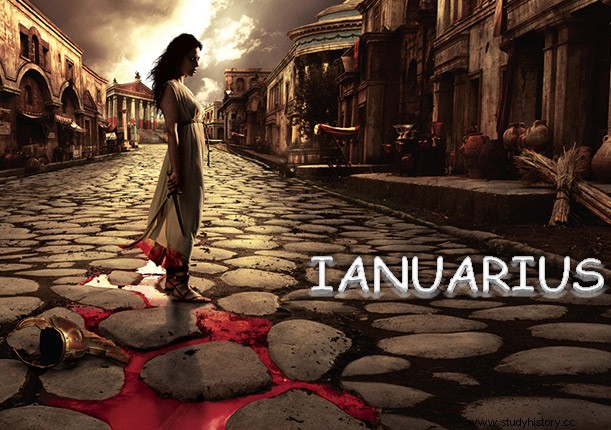Since the calendar reform promoted by Julius Caesar in 45 B.C. (Julian calendar), the first month of the year became 31 days. Ianuarius It was the month dedicated to the god of roads, beginnings and endings, Jano . All that Roman who embarked on a new business, or the arrival of a child or a marriage in the world was consecrated to this native Roman god. He was usually depicted as a two-faced deity, with each face looking in different directions.
One of the rituals that a good citizen had to perform daily were the Ianus Matutinus . The temple of Janus in Rome had twelve doors, one for each month of the year, which were closed in times of peace and open in times of war. Every first day of the month a cake made of bread kneaded with oil and wine was offered to the god, the food triad of classical antiquity that for many centuries was our sustenance.
Kalends of Ianuarius, on day 1.
The first day of the year was the date of changes, of asking for forgiveness and, since the time of Julius Caesar, the day in which the consuls took possession of their annual position and performed the rites in the Capitol in pursuit of the prosperity of the Nation. But, in addition, it was also the day consecrated to the goddess of health, Strenia . It was the day of the bonus, a tradition that dates back to the times of Tacio and Rómulo, when the kings received as a gift from the people for the new year some verbena branches from the forest consecrated to the goddess. Over time, this symbolic present was modified and enriched, becoming known as strena and anticipating its delivery to the Saturnalia , like our current Christmas gifts. It was the emperor Tiberius who arranged that these gifts be limited only to the kalends of Ianuarius. In Valencia we still call "premiere" the little money that each uncle gives to his nephews at Christmas.
The concept of aguinaldo also has its Roman origin. It means "of the year" and consisted of a marzipan (martius panis , March bread, which was the first month of the Roman year until the Julian reform) in the shape of a circular snake decorated with candied fruit and candies… Could this colorful sweet be the predecessor of the roscón de reyes? The truth is that it looks a lot like it... In addition, it was served inside a very showy box that the children later used to store their toys.
On January 5, the dead were honored by placing offerings to the Manes to evoke protective spirits. This rite was known as the Compitalia .
Day 6 was dedicated to the minor god of Hellenic origin Aion and on the 9th to the Agonistic Games in honor of the heroes and demigods style Aeneas, Achilles or Hercules of divine father and mortal mother. In the twilight of the 9th, the priests sacrificed male animals with black fur in honor of these idolized characters.
On the 11th, and later on the 15th, the Carmentalias took place. , the festivities in honor of Carmenta , originally a nymph of the sources that came to be considered a minor divinity associated with divination and births. She was the patron saint of midwives. For this reason, the offerings to this divinity had to be bloodless, since life was honored and not death; Clothing with leather or fur could not be worn during these festivities.
During the Ides of Ianuarius, on the 13th, the title of Augustus was granted to Octavian, the first emperor of Rome. They were dates related to female fertility under the protection of Jupiter Optimal Maximum .
There is a very interesting anecdote related to the Carmentalias, according to the legend caused by a play on words (Carmenta / Carpenta ). It seems that a Senate decree prohibited women from using the carpentum when traveling. (carriage, hence the word carpenter, the one who makes carriages). In retaliation, the women of Rome opted for such severe chastity with their husbands that it caused such an alarming drop in birth rates that the Senate had to revoke the law. In recognition of the intervention of the goddess, a temple was erected to Carmenta and a second day of festivities was dedicated to her.

Collaboration of Gabriel Castelló author of Bravery .
